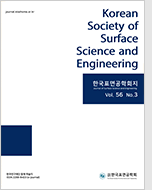
- Past Issues
- e-Submission
-

2021 Impact Factor 1.766
5-Year Impact Factor 1.674
Editorial Office
- +82-2-563-0935
- +82-2-558-2230
- submission@kssse.or.kr
- https://www.kssse.or.kr/

2021 Impact Factor 1.766
5-Year Impact Factor 1.674
The Korean Society of Surface Science and Engineering 2023;56(4):227-232. Published online: Aug, 30, 2023
DOI : https://doi.org/10.5695/JSSE.2023.56.4.227
In this study, complex admittance as a function of temperature and frequency was measured to analyze the important relaxation properties of lead scandium niobate, which is physically important, although it is not an environmentally friendly electrical and electronic material, including lead. Lead scandium niobate was synthesized by heat treating the solid oxide, and the conductance, susceptance and capacitance were measured as a function of temperature and frequency from the temperature dependence of the RLC circuit. The relaxation characteristics of lead scandium niobate were found to be affected by contributions such as grain size, grain boundary characteristics, space charge, and dipole arrangement. As the temperature rises, the maximum admittance and susceptance increase in one direction, but the resonance frequency decreases below the transition temperature but increases after the phase transition.
Keywords PSN ; Dielectric relaxation ; Cole-Cole diagram ; Thermal fluctuation.